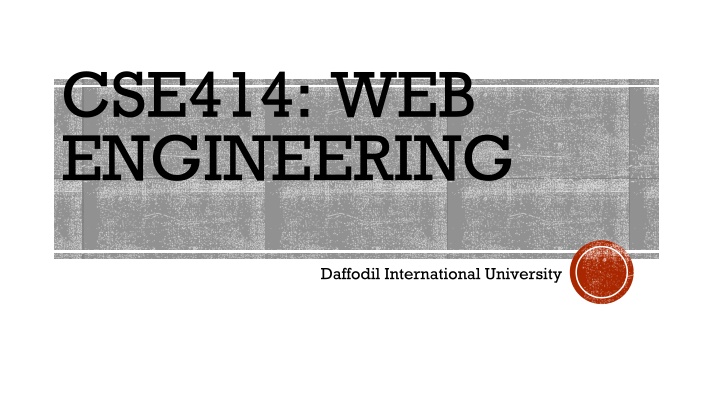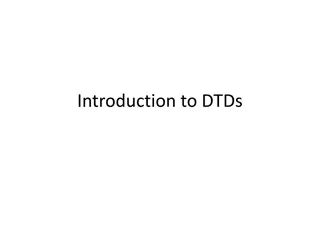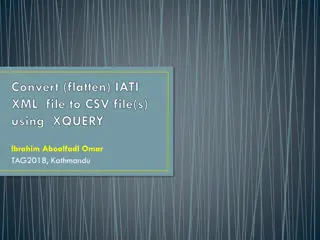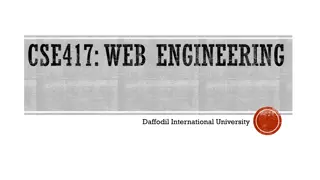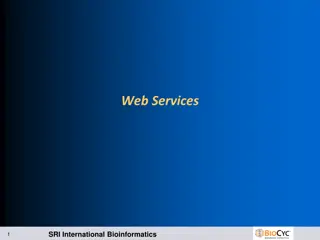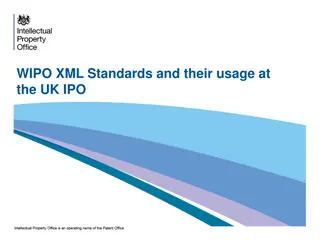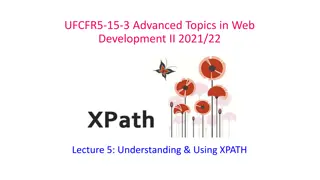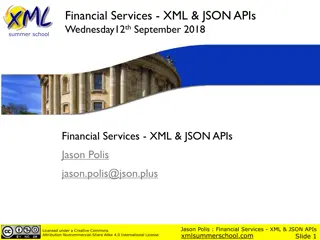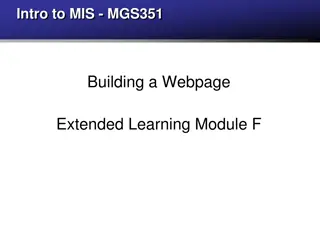Introduction to XML and Web Engineering
"XML, or eXtensible Markup Language, is a crucial tool for storing and transporting data in IT systems. Learn about the basics of XML, its role in various software applications, and how it complements HTML for data presentation and separation. Explore examples and usage scenarios to understand the significance of XML in web engineering."
Download Presentation

Please find below an Image/Link to download the presentation.
The content on the website is provided AS IS for your information and personal use only. It may not be sold, licensed, or shared on other websites without obtaining consent from the author.If you encounter any issues during the download, it is possible that the publisher has removed the file from their server.
You are allowed to download the files provided on this website for personal or commercial use, subject to the condition that they are used lawfully. All files are the property of their respective owners.
The content on the website is provided AS IS for your information and personal use only. It may not be sold, licensed, or shared on other websites without obtaining consent from the author.
E N D
Presentation Transcript
CSE414: WEB ENGINEERING Daffodil International University
LEARNING OUTCOMES Basic concepts of- XML JSON Ajax
XML XML stands for eXtensible Markup Language. XML was designed to store and transport data. XML was designed to be both human- and machine-readable. Why Study XML? XML plays an important role in many different IT systems. XML is often used for distributing data over the Internet. It is important (for all types of software developers!) to have a good understanding of XML.
XML USAGE XML Separates Data from Presentation XML does not carry any information about how to be displayed. The same XML data can be used in many different presentation scenarios. Because of this, with XML, there is a full separation between data and presentation. XML is Often a Complement to HTML In many HTML applications, XML is used to store or transport data, while HTML is used to format and display the same data. XML Separates Data from HTML When displaying data in HTML, you should not have to edit the HTML file when the data changes. With XML, the data can be stored in separate XML files. With a few lines of JavaScript code, you can read an XML file and update the data content of any HTML page.
<?xml version="1.0" encoding="UTF-8"?> <bookstore> XML EXAMPLE <book category="cooking"> <title lang="en">Everyday Italian</title> <author>Giada De Laurentiis</author> <year>2005</year> <price>30.00</price> </book> <book category="children"> <title lang="en">Harry Potter</title> <author>J K. Rowling</author> <year>2005</year> <price>29.99</price> </book> Example 1 <?xml version="1.0" encoding="UTF-8"?> <note> <to>Tove</to> <from>Jani</from> <heading>Reminder</heading> <body>Don't forget me this weekend!</body> </note> Example-2 <book category="web"> <title lang="en">XQuery Kick Start</title> <author>James McGovern</author> <author>Per Bothner</author> <author>Kurt Cagle</author> <author>James Linn</author> <author>Vaidyanathan Nagarajan</author> <year>2003</year> <price>49.99</price> </book> </bookstore>
XML The image in left represents books in this XML: <?xml version="1.0" encoding="UTF-8"?> <bookstore> <book category="cooking"> <title lang="en">Everyday Italian</title> <author>Giada De Laurentiis</author> <year>2005</year> <price>30.00</price> </book> <book category="children"> <title lang="en">Harry Potter</title> <author>J K. Rowling</author> <year>2005</year> <price>29.99</price> </book> <book category="web"> <title lang="en">Learning XML</title> <author>Erik T. Ray</author> <year>2003</year> <price>39.95</price> </book> </bookstore> XML Tree Structure More on XML
JSON JSON: JavaScript Object Notation. JSON is a syntax for storing and exchanging data. JSON is text, written with JavaScript object notation Exchanging Data Data between a browser and a server, the data can only be text. JSON is text, and we can convert any JavaScript object into JSON, and send JSON to the server. We can also convert any JSON received from the server into JavaScript objects.
JSON SYNTAX JSON syntax is derived from JavaScript object notation syntax: Data is in name/value pairs Data is separated by commas Curly braces hold objects Square brackets hold arrays JSON data is written as name/value pairs. "name":"John" In JSON, keys must be strings, written with double quotes: { "name":"John" } In JavaScript, keys can be strings, numbers, or identifier names: { name:"John" }
MORE JSON SYNTAX With JavaScript you can create an object and assign data to it, like this: var person = { name: "John", age: 31, city: "New York" }; You can access a JavaScript object like this: person.name; // returns John person["name"];// this also works Data can be modified like this: person.name = "Gilbert";//Another way to do it? JavaScript arrays can also be used as JSON. [How?] Parse the data with JSON.parse(), and the data becomes a JavaScript object.
MORE Arrays in PHP will also be converted into JSON when using the PHP function json_encode() <?php $myArr = array("John", "Mary", "Peter", "Sally"); $myJSON = json_encode($myArr); echo $myJSON; ?> JSON can be used along with Ajax, html, php, JS too There are other functions too: json_decode(), stringify() etc. What are the purpose of these functions?
JSON VS XML JSON is Like XML Because Both JSON and XML are "self describing" (human readable) Both JSON and XML are hierarchical (values within values) Both JSON and XML can be parsed and used by lots of programming languages Both JSON and XML can be fetched with an XMLHttpRequest JSON is Unlike XML Because JSON doesn't use end tag JSON is shorter JSON is quicker to read and write JSON can use arrays Question: Why JSON is Better Than XML?
AJAX AJAX = Asynchronous JavaScript And XML. AJAX is not a programming language. Read data from a web server - after the page has loaded Update a web page without reloading the page Send data to a web server - in the background AJAX just uses a combination of: A browser built-in XMLHttpRequest object (to request data from a web server) JavaScript and HTML DOM (to display or use the data) AJAX is a misleading name. AJAX applications might use XML to transport data, but it is equally common to transport data as plain text or JSON text.
HOW AJAX WORKS 1. An event occurs in a web page (the page is loaded, a button is clicked) 2. An XMLHttpRequest object is created by JavaScript 3. The XMLHttpRequest object sends a request to a web server 4. The server processes the request 5. The server sends a response back to the web page 6. The response is read by JavaScript 7. Proper action (like page update) is performed by JavaScript
Example Before After
More The keystone of AJAX is the XMLHttpRequest object. Ajax Request var xhttp = new XMLHttpRequest(); //Creates a new XMLHttpRequest object The XMLHttpRequest object is used to exchange data with a server. xhttp.open("GET", "demo_get.asp", true);xhttp.send(); Can we use POST method? With the XMLHttpRequest object you can define a function to be executed when the request receives an answer. The function is defined in the onreadystatechange property of the XMLHttpRequest object: xhttp.onreadystatechange = function() { if (this.readyState == 4 && this.status == 200) { document.getElementById("demo").innerHTML = this.responseText; } }; xhttp.open("GET", "ajax_info.txt", true); xhttp.send(); More
THE ONREADYSTATECHANGE PROPERTY The readyState property holds the status of the XMLHttpRequest. The onreadystatechange property defines a function to be executed when the readyState changes. The status property and the statusText property holds the status of the XMLHttpRequest object. Property Description onreadystatechange Defines a function to be called when the readyState property changes readyState Holds the status of the XMLHttpRequest. 0: request not initialized 1: server connection established 2: request received 3: processing request 4: request finished and response is ready status 200: "OK" 403: "Forbidden" 404: "Page not found" For a complete list go to the Http Messages Reference statusText Returns the status-text (e.g. "OK" or "Not Found")
More AjaxResponse The onreadystatechange function is called every time the readyState changes. When readyState is 4 and status is 200, the response is ready: function loadDoc() { var xhttp = new XMLHttpRequest(); xhttp.onreadystatechange = function() { if (this.readyState == 4 && this.status == 200) { document.getElementById("demo").innerHTML = this.responseText; } }; xhttp.open("GET", "ajax_info.txt", true); xhttp.send(); }
WHATS MORE in this course? Now we will be choosing an Independent topic!! For each group, there will be one topic, it can be anything Implement basic idea of that You will present/demonstrate You have one week to do that! Few topics: Web Services Django Laravel REST CGI Programming Cloud look-why-these-top-web-development-trends-technologies-will-rule
EXERCISE Use JSON, XML and Ajax at least once in your project! READINGS https://www.w3schools.com/xml/ https://www.w3schools.com/js/js_json_intro.asp https://www.php.net/manual/en/book.json.php
ACKNOWLEDGEMENT This module is designed and created with the help from following sources- https://cgi.csc.liv.ac.uk/~ullrich/COMP519/ http://www.csc.liv.ac.uk/~martin/teaching/comp519/ Md. Al-Amin Hossain, Daffodil International University
